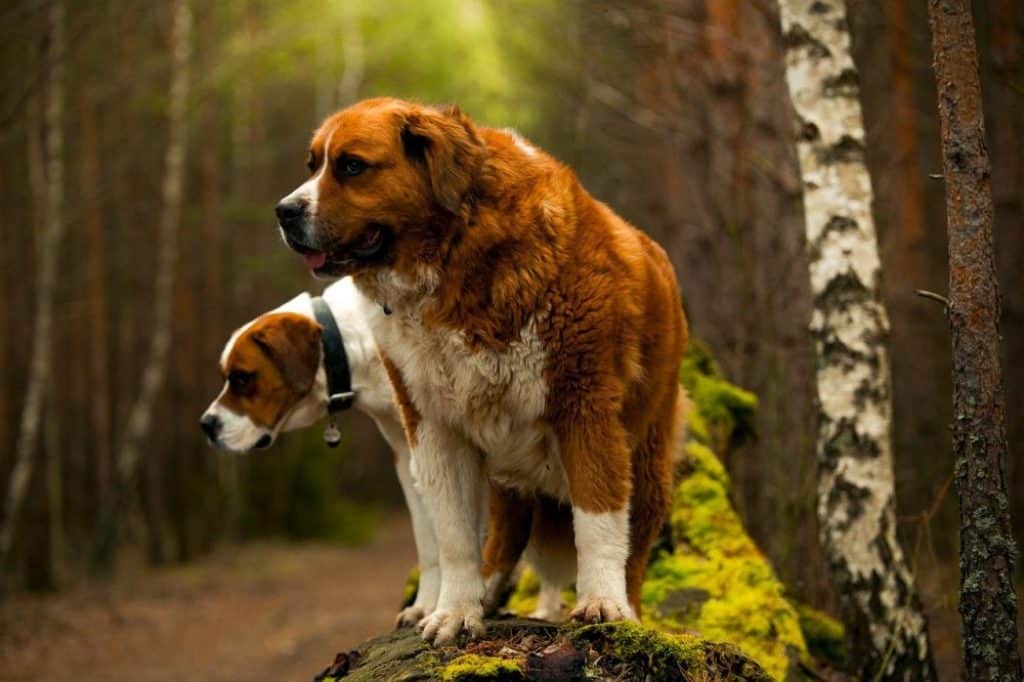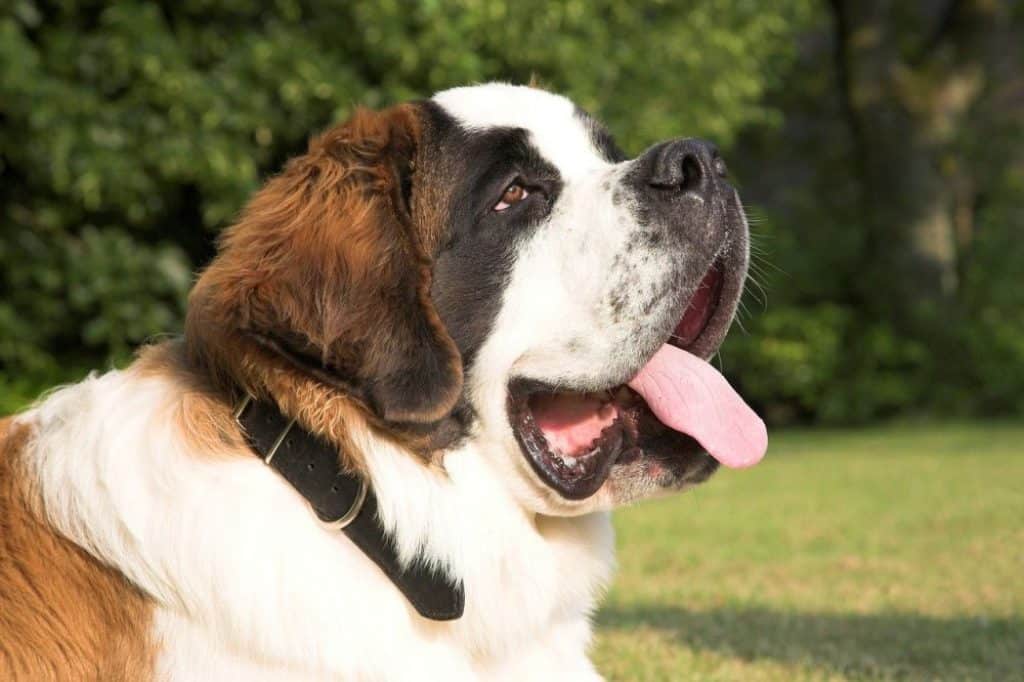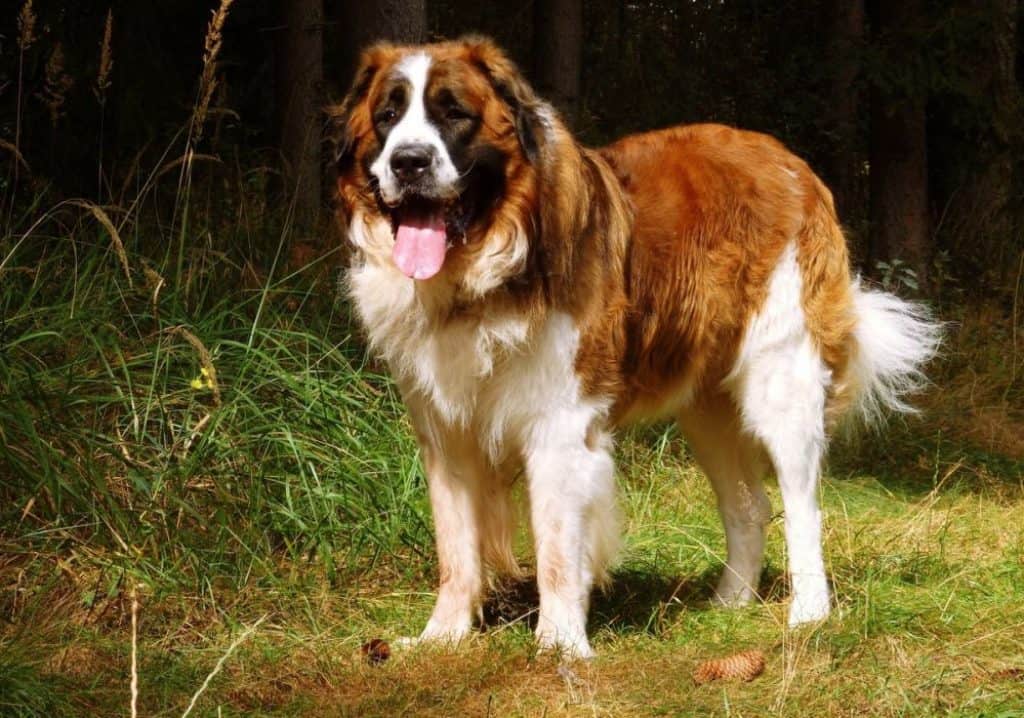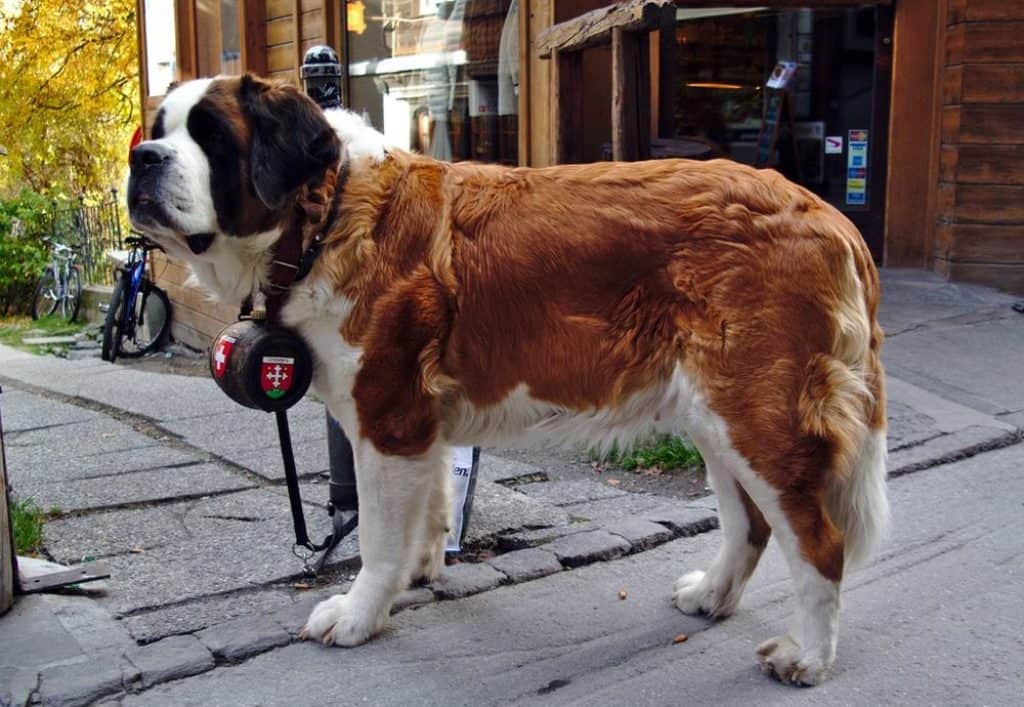Dogs since time immemorial have been bred to act as a guardian to man. However, different dog breeds have different protective potentials.
Some are fiercely protective, and others are moderately protective.
With that said, some dog breeds, like the Saint Bernard dog breed, stands out when it comes to their protective temperament.
So, if you have already adopted this gentle and calm hound or you are thinking of doing so and you are wondering, ‘Are Saint Bernards good guard dogs?’ and ‘Are Saint Bernards protective?’ then read on as I got you covered through this article.
I will be providing you with factual answers as to whether Saint Bernards are protective and if they can make good guard dogs.
I will also give you the telltale signs that indicate your dog will, without any hesitation, protect you in the event of a threat or danger.
Don’t miss out on how to find out if your Saint Bernard is a good guard dog as I have provided you with the know how in this article.
Please make sure that you also learn how to train your Saint Bernard to be an excellent guard dog by browsing to the end of the text.
[wpsm_toplist]
Are Saint Bernards Protective?

Yes, Saint Bernards are innately protective, especially to their owners or those they consider family.
However, it’s crucial that you pay close attention to your Saint Bernard’s protective behavior as this dog can quickly become overprotective of you.
Are Saint Bernards Good Guard Dogs?
Yes, Saint Bernards make good guard dogs when adequately trained at a young age.
Their large body size (an average height of 32-37 inches and an approximate weight of 54-82 kgs) makes them an ideal guard dog.
Their alert, protective, friendly, easy-to-train nature coupled with their ability to not to resort to aggression even when provoked makes them good guard dogs to have around.
Saint Bernards have the potential to become aggressive and somewhat bossy when inadequately trained at a young age.
So be sure to adopt an ‘Alpha mentality’ and professionally qualm any aggressive or dominating behavior that your hound may be trying to develop.
They are moderately energetic, which may somewhat make them tire fast during their guarding tasks.
However, it’s possible to increase their energetic potential and endurance power.
You can do this by; Providing your Saint Bernard with a balanced diet that takes time to digest.
Consider feeding your hound with an omnivorous diet. That is, it’s filled with enough and balanced proteins, carbohydrates, and vitamins.
NOTE! Saint Bernards are at risk of becoming obese. So don’t overfeed them. Please provide them with fresh and cooked meals at least 2 times a day.
Also, consider engaging it in exercises that are aimed at boosting its stamina. Such activities include; swimming, power walking, and running.
Ensure that you have your Saint Bernard perform these exercises every day for around 30-40 minutes.
How Can I Find Out If My Saint Bernard Will Protect Me?

Finding out whether your Saint Bernard will protect you is quite easy.
All you need to do is create a suggestive scenario that shows you are in danger and in need of help.
Be sure to have your dog on a leash, as sometimes this kind of testing may escalate quickly to a life-threatening situation, especially when your hound doesn’t take your safety lightly!
You can have your friend run towards you as though they are about to attack you.
Dogs get triggered to react to any fast-moving thing, may it be a person, an animal, or a car.
And if your Saint Bernard is protective to you, then it will react to the ‘run’ by;
Becoming Excessively Vocal
Your saint bernard will bark, growl, and even whine to intimidate your purported aggressor.
The barking sound is usually low-pitched and often accompanied by growling and sometimes whining.
Assumes An Aggressive Dog Posture
When your Saint Bernard assumes an aggressive dog posture, it simply means that;
Its whole body becomes tensed up due to the stiffening of its muscles.
You may notice its back hair standing erect and also its ears and tail tend to assume a straight position.
The tail is usually wagged to the right.
It may also crouch down or slightly lift one of its paws to warn the intruder it is about to pounce on them forcefully.
It Gives The Aggressor The ‘Biting’ Signs
Despite being extremely calm and gentle, Saint Bernards may resort to biting if they feel it’s necessary.
So, if your hound is ready to protect you, it will give your aggressor the ‘biting’ signs, which are;
Air snapping, Lip licking, barring their teeth in a way the mouth assumes a C-shape and growling.
Saint Bernards also use their eyes to indicate that they are about to get mouthy or bitey.
So, if you notice your hound is exposing only the whites of its eyes (known as the whale eyes), gives your aggressor a hard stare, or has its pupils dilated, then it’s safe to assume that your hound is ready to protect you by using its powerful and muscular jaws.
Extra tip; It’s vital that during your enactment, you have your aggressor put on an anti-dog bite suit.
If you cannot access this protective gear, lock your dog in its cage, which should be see-through.
Also, ensure that your ‘alleged aggressor’ puts on a headgear that covers their face and only exposes their eyes and mouth.
Remember dogs, especially Saint Bernards, ace at remembering faces, and you don’t want your harmless friend being attacked just because your Saint Bernard remembered its owner’s aggressor’s face.
How Do I Know If My Saint Bernard Is A Good Guard Dog?

If your Saint Bernard has at least 5 of the qualities mentioned below, then it’s safe to assume that you are a dog parent of an excellent guard dog;
#Bold And Confident
A guard dog’s primary purpose is to protect its owner or its owner’s property.
This makes it paramount that a dog be bold and confident in what it’s guarding task(s).
#Loyal
Its loyalty should be indisputable even in the absence of its owner.
#Intellegent
An intelligent dog tends to grasp its guarding training fast.
This makes it essential that a dog be smart if it is to make an exceptional guard dog.
#Affectionate
For a dog to make an excellent guard dog, it should be affectionate to its owners and those around it.
This includes everyone in the household (other dogs or other pets).
#Doesnt Act Out Of Fear Or Slight Provocation
A good guard dog shouldn’t resort to aggression out of fear or due to a light provocation.
It should be calm and know how to handle a situation without hostility.
#Independent
It should be able to stay or do things on its own even when its human parents are not around.
#Agile And Energetic
A good guard dog should be agile and fast to react, and energetic enough to do its guarding job without slacking down.
#Decisive
An excellent Saint Bernard guard dog should be able to make its own decisions (which should be in the interest of its owner) even without being commanded to do so.
How Do I Train My Saint Bernard To Be A Good Guard Dog?

Below is a complete guide on how to train your Saint Bernard to be a good guard dog.
NOTE! All the steps expounded on below are integrated and systematic. That is, you cannot skip one and do the other.
And also, you cannot start from the last step as you go up as this will only confuse your dog, which may be hard to reverse.
#Earn Its Trust
Before starting its guarding training, you must first earn your Saint Bernard’s trust.
Note! Saint Bernards are naturally cautious (an attribute that makes them a good guard dog), and so they may or may not be too friendly to you on your first ‘date’ or meet-up.
So, in order to gain its trust, start by befriending it at the breeder’s place.
Let it see you talking to its caregiver (which is the breeder). Use treats, pet its back (after breaking the physical barrier, of course).
Don’t maintain eye contact with your potential guard hound. Dogs perceive eye contact as a challenge.
And trust me when I tell you Saint Bernards never back down on one!
After adopting your hound, provide it with enough water and food and a clean place to stay or live.
If it’s a young pup, you can let it sleep in your bed, but after potty training it, which may take around 4-6 months.
Also, remember to give your dog enough attention and properly teach it how to detach from you.
This helps avoid the development of future separation anxiety attacks and aggressive behaviors, all of which are caused by improper desensitization to being left alone.
#Competently Train It Basic Obedience Commands
After earning your dog’s trust, it will be easy to train it the essential basic obedience commands.
Teach it to ‘sit’, ‘come’, and ‘No’. Use treats to reinforce good behaviors. Ensure that you find what it is that your dog considers to be a treat and maximize on it.
For instance, if your dog sees a treat as anything edible, then consider giving it small-sized treats that are soft and chewy.
After training your dog on basic obedience commands, it’s crucial that you thoroughly socialize it with the outside world.
Consider taking it out to a dog park. Please don’t go out without putting a leash on your dog.
You can also purchase your Saint Bernard a muzzle for extra security and have it put on whenever you go out.
You can also arrange a play date for your doggy with an adequately socialized dog. Just be sure that the dogs spending time or playing with your hound are not ‘bullies.
Letting your gentle pup spend time with a dog that is bullying it may cause it to deteriorate in both its physical and mental health.
If your dog is exhibiting signs of fear, anxiety or is hesitant to go out and play, or has constant fresh bruises or marks on its skin, then please don’t force it too as all these are signs that your dog is getting bullied by the other hound(s).
#Hire A Pro And Let Them Train Your Saint Bernard Complex Guarding Commands
Unless you are a pro, I highly recommend that you hire a pro and let them handle your dog’s advanced guarding training.
Let a guru train your dog the bark, quiet, run, restrain a person/something and maybe bite command.
NOTE! A wrongly approached advanced dog guarding training is hard to reverse.
It can also make your hound develop aggressive behaviors, which may make it hard to live with it under the same roof.
#Boundary Train Your Dog
Let your Saint Bernard know where your property starts and where it ends. Try and train it in an unfenced compound to make it more effective.
Start by taking your hound to the furthest point of your property’s boundary while pointing to the ground.
Use something to mark where it shouldn’t cross.
Repeat this for at about 3-4 times a day in a period of 1-2 weeks. Stop pointing at the ground after the specified period.
Instead, move your hands in a sweeping motion as a way of showing it its boundaries. Still have your dog on a leash. Also, do this for 1-2 weeks for about 2 times a day.
After you are comfortable that your dog is familiar with your property boundary, walk with it to the end of the perimeter without putting it on a leash.
Command it to sit or stop. If it doesn’t cross the marked boundary use treats to reinforce its positive achievement.
Do this for another 2-3 weeks before letting it guard your property off-leash and unsupervised.
#Test Its Guarding Capabilities/Skills
Put your Saint Bernard’s guarding skills to the test by staging a performance.
Have your friend knock at the door or attempt to gain entrance to your compound/property.
Give your dog time to react and watch how it responds to an intruder.If your hound barks. Give it the quiet command.
If it automatically keeps silent, then know your dog’s guarding training was successful, and it’s time to put it to work.
Extra tip: When sufficiently and appropriately trained, Saint Bernards can become an excellent guard dog.
This means that it can easily pin down an intruder or even injure them (rarely happens unless the intruder intensely provokes it to do so).
This makes it essential that you at least notify people that you own a fierce guard dog by putting up a sign on all your home’s entrances.
This will not only protect you from having numerous court proceedings but will also deter trespassers from coming into your property.
Conclusion
So, are Saint Bernards protective and good guard dogs?
Yes, Saint Bernards are protective.
They are also loyal, watchful, devoted, bold, and don’t act out of fear or slight provocation, which makes them good guard dogs when adequately trained at a young age.
Their large size also serves as an additional advantage for anyone looking for an intimidating guard dog.
However, it’s essential that you keep a close watch on their protective temperament as they can sometimes be overprotective of their owner.
In order to successfully train your dog to be a good guard dog, first, earn its trust and competently teach it basic obedience commands.
Proceed to socialize it adequately, and then hire a pro to train it advanced guarding skills.
Don’t forget to boundary train it and then test it if it actually grasped its training by staging a performance.
Always have your Saint Bernard put on its leash during its guarding training.







